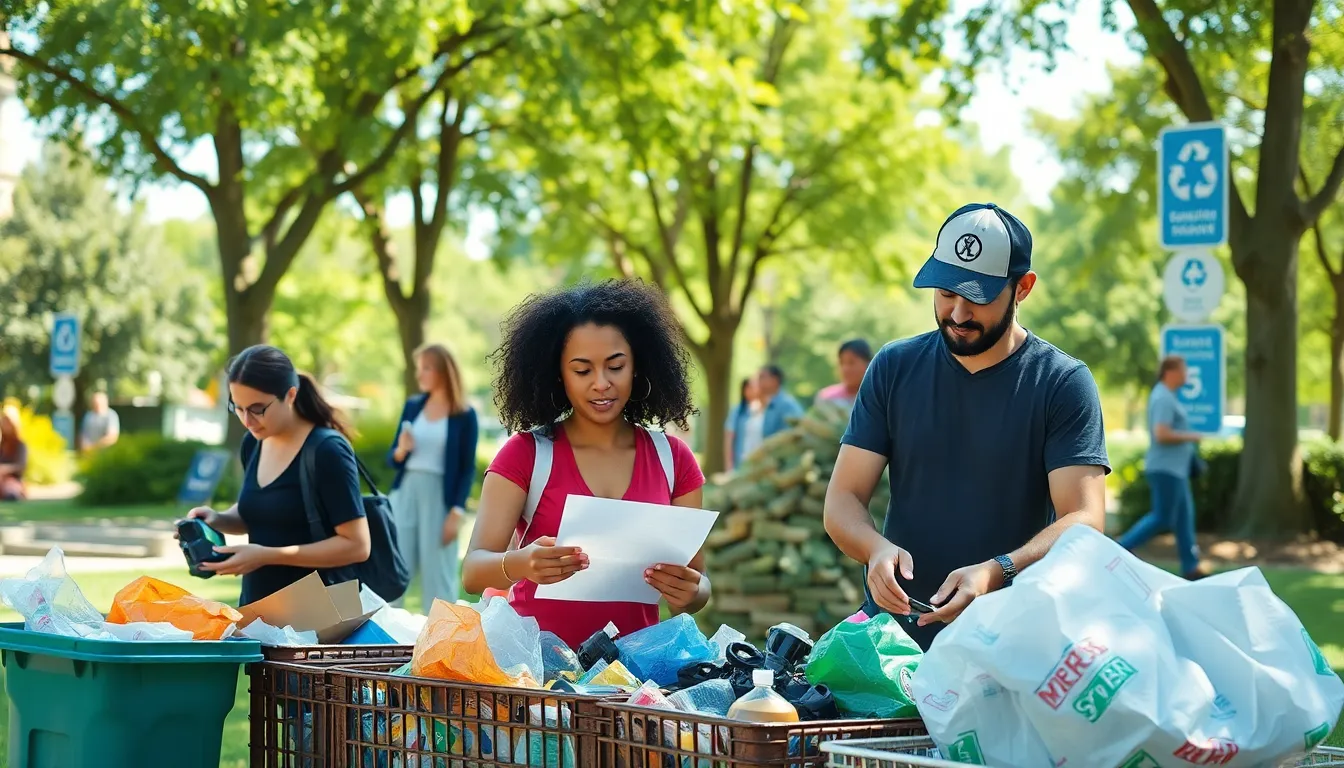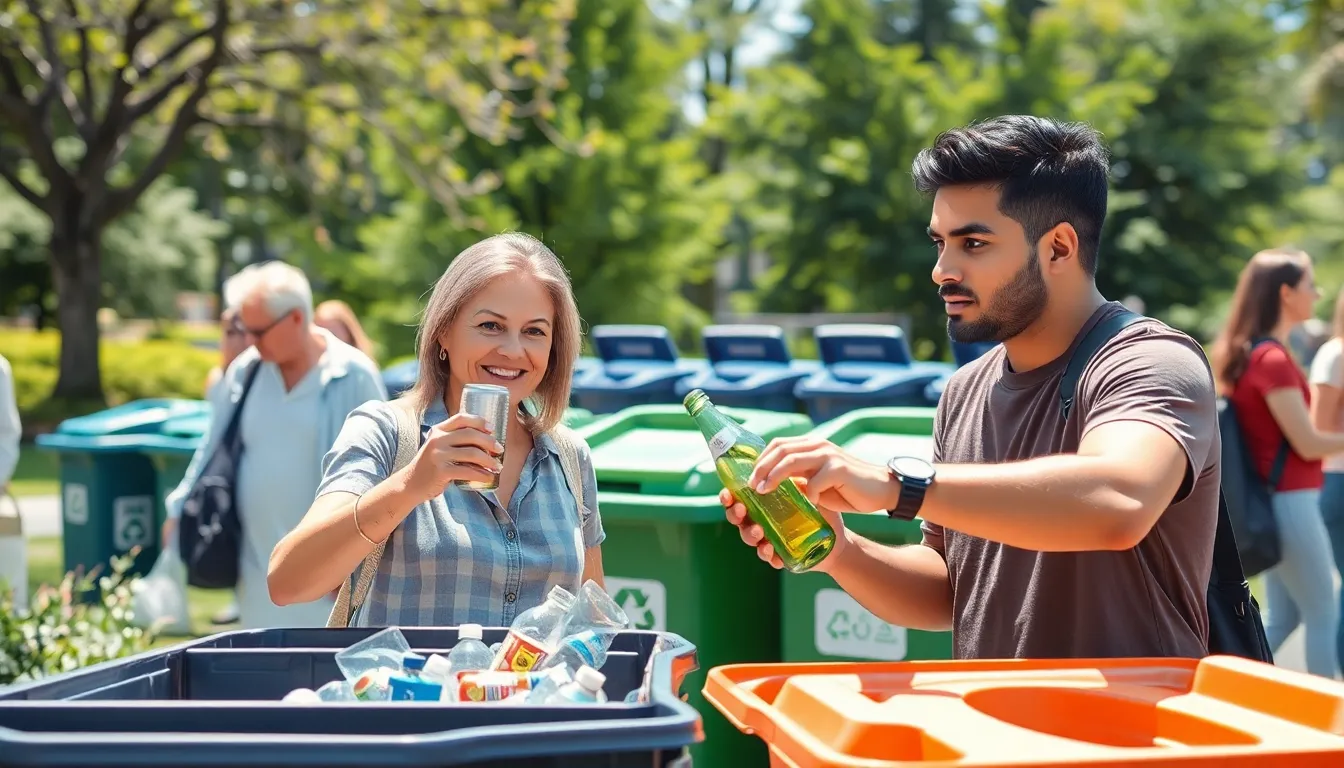In a world drowning in plastic and overflowing with waste, recycling might just be the superhero we didn’t know we needed. It’s like giving Mother Earth a much-needed spa day while saving a few bucks in the process. But let’s face it—navigating the recycling maze can feel like trying to solve a Rubik’s Cube blindfolded.
Table of Contents
ToggleOverview of Recycling Guidelines
Recycling guidelines exist to simplify the recycling process and enhance participation. Single-stream and dual-stream systems differ in their sorting methods, affecting what materials can be recycled together. When engaging in recycling, knowing local guidelines remains crucial, as communities establish specific rules based on their recycling facilities.
Avoid contamination by rinsing out containers and removing labels when necessary. Contaminated items disrupt the recycling process and can lead to entire batches being sent to landfills. Items like aluminum cans, glass bottles, and certain plastics typically fall under recyclable materials, while others like plastic bags and pizza boxes often do not.
Understanding proper categorization helps improve recycling rates. Many jurisdictions accept materials like paper and cardboard, but these must stay free from food residue. Residents need to familiarize themselves with accepted materials by consulting local recycling programs or websites.
Additionally, residents can reduce waste by reusing items before recycling. Items like glass jars and plastic containers often serve multiple purposes around the home. Always check with local recycling facilities for any updates or changes in processes, as guidelines can frequently evolve based on technological advancements and market requirements.
Promoting community awareness on recycling initiatives enhances effectiveness. Educational campaigns and workshops empower individuals to engage fully in recycling practices. Frequent updates on what can be recycled and changes in local policies foster a proactive approach among citizens, supporting cleaner environments and more sustainable practices.
Importance of Recycling

Recycling plays a vital role in creating a sustainable future for the planet and society. It significantly reduces waste, conserves resources, and fosters a healthier environment.
Environmental Impact
Recycling reduces landfill contributions, cutting down on greenhouse gas emissions. It conserves natural resources, minimizing the need for raw materials. By recycling paper, trees can be preserved, supporting biodiversity. Recycling metals decreases the energy consumption needed for extraction and processing. Water conservation results from recycling, as less is required in manufacturing processes. Communities benefit from improved air and water quality, reducing pollution levels. Sustainable practices stem from increased recycling efforts, fostering a culture of environmental responsibility.
Economic Benefits
Recycling generates economic growth, creating jobs within the recycling and manufacturing industries. Local job markets strengthen through recycling initiatives, contributing to community development. Reduced waste management costs result from lower landfill use. Manufacturing processes become more efficient as recycled materials lower production costs. Tax revenues may increase from businesses that thrive due to sustainable practices. Long-term savings arise for households and governments through decreased disposal expenses. When communities prioritize recycling, they enhance their economic resilience and sustainability.
General Recycling Guidelines
Recycling effectively involves knowing what can and cannot be recycled. Understanding these guidelines helps reduce contamination and promotes better recycling practices.
Common Recyclable Materials
Common items include aluminum cans, glass bottles, and cardboard boxes. Paper products such as newspapers and magazines also fit into this category. Many municipalities accept plastic containers labeled with recycling symbols 1 and 2. Electronics like mobile phones and computers often qualify for specialized recycling programs. Knowing the specifics of local regulations ensures proper disposal of these items.
Items That Cannot Be Recycled
Certain materials cannot be recycled, leading to contamination. Plastic bags and wraps often disrupt sorting machinery at recycling facilities. Additionally, food-contaminated items like pizza boxes pose challenges due to grease and residue. Styrofoam and polystyrene products typically end up in landfills instead of recycling bins. Hazardous waste, including batteries and certain electronic devices, requires special handling and should not enter standard recycling streams. Understanding these exclusions aids in responsible disposal and supports recycling efforts.
Local Recycling Regulations
Understanding local recycling regulations ensures effective participation in recycling programs. Regulations vary significantly by location, making it essential to familiarize oneself with specific guidelines.
How to Find Your Local Guidelines
Finding local recycling guidelines requires a few straightforward steps. Check city or county websites, as they often publish detailed information about recycling rules. Many municipalities provide downloadable guides that outline acceptable materials and collection schedules. Websites also feature tools for residents to input their address, providing tailored guidelines. Social media pages or community bulletins often share updates on recycling initiatives, making them valuable resources. Local waste management offices can assist with questions regarding unusual items or changes in regulations.
Understanding Recycling Symbols
Recycling symbols play a crucial role in identifying recyclable materials. Each symbol typically includes a number inside a triangle, representing specific types of plastics. The numbers range from 1 to 7, indicating different resin types, with numbers 1 and 2 being widely accepted in most programs. Familiarizing oneself with these symbols helps residents make informed decisions about what to recycle. Additionally, some symbols denote general recyclability or compostability, providing guidance on proper disposal methods. Understanding these symbols empowers individuals to reduce contamination and enhance recycling effectiveness in their communities.
Best Practices for Effective Recycling
Effective recycling begins with understanding local guidelines. Residents must consult city or county websites for specific recycling rules. Frequent checking of local updates enhances awareness of any changes in regulations.
Proper preparation of recyclables plays a critical role. Rinsing containers before disposal eliminates contaminants that disrupt the recycling process. Labels should be removed from plastic and glass items to prevent contamination.
Sorting materials correctly boosts recycling efficiency. Single-stream systems allow all recyclables in one bin, while dual-stream systems require separation of materials. Familiarizing oneself with these systems can simplify recycling at home.
Challenge exists with certain items that aren’t recyclable. Plastic bags, pizza boxes, and Styrofoam often complicate recycling efforts. Knowing what materials are acceptable helps residents avoid improper disposal.
Community engagement promotes better recycling practices. Educational campaigns and workshops inform residents about recycling benefits and procedures. Increased participation in local recycling initiatives leads to greater environmental impact.
Sustainability relies on reusing items before recycling. Donating or repurposing items extends their life cycle and conserves resources. This practice supplements recycling efforts and supports a sustainable lifestyle.
Awareness of recycling symbols aids in identifying recyclable materials. Familiarity with these symbols contributes to better decision-making and reduces contamination. Understanding specific plastic types encourages thoughtful recycling habits.
Heeding these best practices can significantly improve local recycling rates. Prioritizing prevention of contamination alongside proper sorting fosters cleaner environments. Communities thrive when individuals commit to effective recycling strategies.
Embracing recycling is essential for a sustainable future. By understanding local guidelines and best practices, individuals can contribute significantly to reducing waste and conserving resources. The journey toward effective recycling starts with awareness and education.
Communities that prioritize recycling not only create cleaner environments but also foster economic resilience. Engaging in local initiatives and staying informed about recycling symbols empowers everyone to make better choices.
Ultimately, every small effort counts. By committing to proper recycling practices, individuals play a vital role in nurturing the planet and promoting a culture of environmental responsibility.



